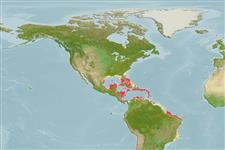Common names from other countries
Environment: milieu / climate zone / depth range / distribution range
Écologie
Récifal; saumâtre; profondeur 0 - 69 m (Ref. 415). Tropical
Western Atlantic.
Length at first maturity / Taille / Poids / Âge
Maturity: Lm ? range ? - ? cm Max length : 250 cm WD mâle / non sexé; (Ref. 99323)
Description synthétique
Morphologie
Barrel shaped, with thick walls. Purple to red brown externally, tan internally. Surface with protuberances with round or blade-like outlines. Brittle and crumbly in consistency. Oscules on the inner side of vase; 0.2 - 0.3 cm (Ref. 415).
Maximum depth reported taken from Ref. 128739.. Maximum length refers to base diameter (Ref. 99323). Common on reef environments (Ref. 415). Also found in mangroves (Ref. 86836). Inhabits shallow coral reefs, coral communities, coralline algae reefs, algal nodules, and mesophotic reefs (Ref. 128739).
Life cycle and mating behavior
Maturité | Reproduction | Frai | Œufs | Fécondité | Larves
Broadcast spawner.
Collin, R., M.C. Díaz, J. Norenburg, R.M. Rocha, J.A. Sánchez, M. Schulze, A. Schwartz and A. Valdés. 2005. (Ref. 415)
Statut dans la liste rouge de l'IUCN (Ref. 130435)
statut CITES (Ref. 108899)
Not Evaluated
Not Evaluated
Utilisations par l'homme
| FishSource |
Outils
Sources Internet
Estimates based on models
Preferred temperature
(Ref.
115969): 26.4 - 28.2, mean 27.5 (based on 519 cells).
Résilience
Très faible, temps minimum de doublement de population supérieur à 14 ans (K=0.04).
Catégorie de prix
Unknown.
